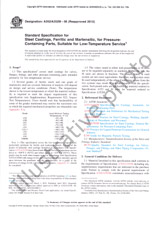We need your consent to use the individual data so that you can see information about your interests, among other things. Click "OK" to give your consent.
ASTM E2311-04(2021)
Standard Practice for QCM Measurement of Spacecraft Molecular Contamination in Space
Translate name
STANDARD published on 1.4.2021
The information about the standard:
Designation standards: ASTM E2311-04(2021)
Publication date standards: 1.4.2021
SKU: NS-1029235
The number of pages: 22
Approximate weight : 66 g (0.15 lbs)
Country: American technical standard
Category: Technical standards ASTM
The category - similar standards:
Annotation of standard text ASTM E2311-04(2021) :
Keywords:
contamination measurement, molecular contamination, outgassing, outgassing rates, quartz crystal microbalance, spacecraft contamination, temperature controlled quartz crystal microbalance,, ICS Number Code 71.040.99 (Other standards related to analytical chemistry)
Additional information
| Significance and Use | ||||
|
5.1?Spacecraft have consistently had the problem of contamination of thermal control surfaces from line-of-sight warm surfaces on the vehicle, outgassing of materials and subsequent condensation on critical surfaces, such as solar arrays, moving mechanical assemblies, cryogenic insulation schemes, and electrical contacts, control jet effects, and other forms of expelling molecules in a vapor stream. To this has been added the need to protect optical components, either at ambient or cryogenic temperatures, from the minutest deposition of contaminants because of their absorptance, reflectance or scattering characteristics. Much progress has been accomplished in this area, such as the careful testing of each material for outgassing characteristics before the material is used on the spacecraft (following Test Methods E595 and E1559), but measurement and control of critical surfaces during spaceflight still can aid in the determination of location and behavior of outgassing materials. |
||||
| 1. Scope | ||||
|
1.1?This practice provides guidance for making decisions concerning the use of a quartz crystal microbalance (QCM) and a thermoelectrically cooled quartz crystal microbalance (TQCM) in space where contamination problems on spacecraft are likely to exist. Careful adherence to this document should ensure adequate measurement of condensation of molecular constituents that are commonly termed contamination on spacecraft surfaces. 1.2?A corollary purpose is to provide choices among the flight-qualified QCMs now existing to meet specific needs. 1.3?The values stated in SI units are to be regarded as the standard. The values given in parentheses are for information only. 1.4?This standard does not purport to address all of the safety concerns, if any, associated with its use. It is the responsibility of the user of this standard to establish appropriate safety, health, and environmental practices and determine the applicability of regulatory limitations prior to use. 1.5?This international standard was developed in accordance with internationally recognized principles on standardization established in the Decision on Principles for the Development of International Standards, Guides and Recommendations issued by the World Trade Organization Technical Barriers to Trade (TBT) Committee. |
||||
| 2. Referenced Documents | ||||
|



 Cookies
Cookies
